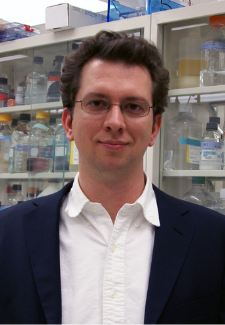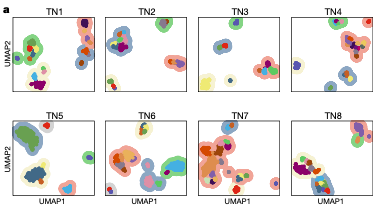
The tumor, once an indistinct mass of heterogeneous cells, is gaining single-cell resolution. Until recently, even distinguishing between healthy cells and malignant cells within a tumor sample presented a challenge. With a new computational approach, however, former Damon Runyon-Rachleff Innovator Nicholas E. Navin, PhD, and his colleagues at MD Anderson Cancer Center have been able to make this distinction with 98% accuracy in a range of solid tumors.
Their approach is called copy number karyotyping of aneuploid tumors (CopyKAT). Given a large set of single-cell RNA-sequencing data, CopyKAT can infer the genetic makeup of each cell in a tumor sample and flag those displaying aneuploidy (an abnormal number of chromosomes)—a hallmark of cancer cells. The examination of chromosomes is called karyotyping, hence the “KAT” part of the name.
But this tool does more than distinguish between cancer cells and normal cells. CopyKAT also analyzes genetic diversity within cancer cell populations, which arises as cancer cells proliferate and are subjected to selective pressures in their environment. Cancer cells can be organized into subpopulations based on how many copies they have of a given gene—the “copy number” element of the approach. Knowing the genetic composition of subpopulations can inform a number of larger questions, including how tumors evolve, which pathways might be targeted, and how effective targeted therapy will be for a given patient
Using CopyKAT to analyze nearly fifty thousand cells from 21 tumors, including breast cancer, pancreatic cancer, and thyroid cancer, researchers were able to reliably distinguish between cancer cells and normal cells in each of the samples. They were also able to identify rare subpopulations of cells within the breast cancer tumors that differed in the expression of certain cancer genes, a finding that may have therapeutic implications.

triple-negative breast tumours
In a separate study, Dr. Navin’s team performed copy number analysis on twelve breast cancer samples in order to delineate the large number of subpopulations present. Further analysis pointed to genetic events—point mutations, increases in copy number, gene deletions—that occurred early in tumor growth to cause such genetic diversity. This data sheds light on the murky process of copy number evolution, which must be understood before it can be halted.
For patients, increased precision in tumor sample analysis will translate to earlier detection, as malignant cells are more easily distinguished, and better prognostics, as the genetic diversity of a tumor is expected to predict its response to therapy. Copy number analysis, aided by tools like CopyKAT, can also guide therapies toward the most malignant subpopulations of tumor cells, specific genes within them, and eventually, to key events in tumor genome diversification.
CopyKAT is freely available here.







